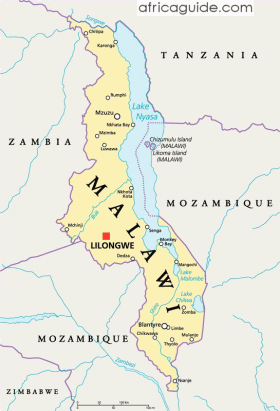Malawi Travel Guide
Parent page
On this page
Introduction
Malawi is a landlocked country located in southeastern Africa. It is bordered in the North and East by Tanzania, on the east, south and southwest by Mozambique and to the west by Zambia.
The country lies within the Great African Rift Valley system. Lake Malawi, a body of water some 360 miles long and about 1,500 ft above sea level, is its most prominent physical feature. Much of the land surface is plateau between 900 to 1,220 m (3,000 to 4,000 ft) above sea level. Elevations rise of over 2,440 m (8,000 ft) in the Nyika Plateau in the north and in the regions of Mt. Mulanje 3,050 m (10,000 ft) and Mt. Zomba 2,135 m (7,000 ft). The Shire highlands in the south are lower with elevations from 610 m (2,000 ft) to 900 m (3,000 ft).
To the north there are rugged highlands with rolling hills in the Nyika and Vwanza plateaux, whilst in the South, traversing the escarpment that forms part of the Great African Rift Valley, lie the lowlands of the Shire Valley.
Lilongwe is the capital city of Malawi and is it's largest city. Malawi's population tops just over over 16 million people, with English and Chichewa being the main languages spoken throughout the country.
Lake Malawi is the county's centerpiece. Like an inland sea it has enless palm fringed beaches, enclosed by sheer mountains, making it undeniably the focal point for Malawi's tourists. It is commonly know as "the lake of stars” and offers the holiday maker a variety of water activities, including scuba diving.
Malawi, although a small country, is very diverse, making it a perfect destination for a holiday, without the mass crowds. It may not be as well known for it's wildlife as it neighbouring Zambia or Tanzania but it does offer comparable and excellent wildlife viewing opportunities, having over 170 species of mammals, including the BIG 5.Malawi has a prolific birdlife, with over 500 species of bird to be found within the country. Most species breed in Malawi but some migrate from Europe and Asia to spend the rainy season in Malawi, with some species preferring to spend the dry months in other areas of Africa. November to January are the best month for birding enthusiasts..
If you are keen on hiking, Malawi's highland areas offer unrivalled opportunities for those wanting to explore the country on foot. Mount Mulanje and Zomba Plateau, in particular are favourites for hikers and mountain climbers alike. In some of the game parks, particularly the Nyika National Park, walking safaris are available under the protection of a wildlife scout.Listen to the Malawi National Anthem

